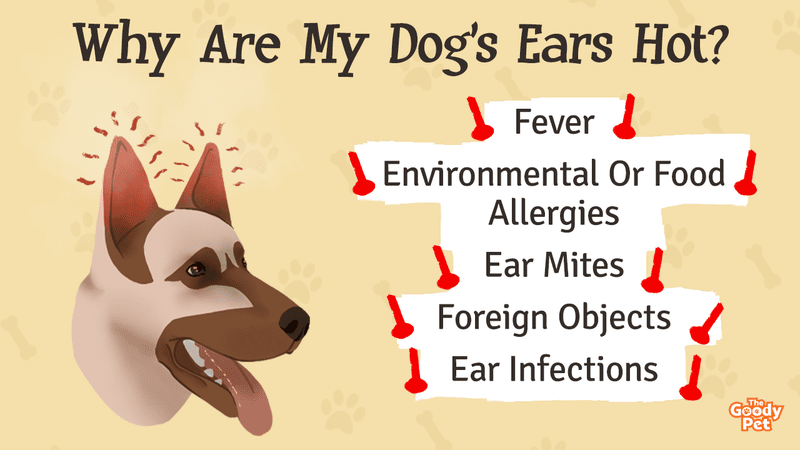If your dog’s tail can ‘speak’ a thousand words, so are those ears. Did you know that a dog’s ears can give you information about its state of mind and well-being? Ears in a relaxed position indicate calmness, whereas ears pointing up mean curiosity. In addition, ears tilted backward may mean stressed, fearful, or aggressive behavior.
What if your dog’s ears are hot and, in some cases, unusually reddish? One reason is that your fur baby can be running a high fever. With the help of a pet thermometer, the normal body temperature ranges from 99.5°F to 102.5°F, so anything above this indicates a fever. But if the temperature is normal, another possible reason for hot ears is an ear infection.
In this article, we’d be touching on the different issues why your dog’s ears are hot to the touch. Should you be alarmed, does your pooch require immediate vet attention? Let’s get the answers now so you can respond the right way and save your dog’s life.
What Does It Mean If A Dog’s Ears Are Hot?

There are many reasons why your dog’s ears are hot. Aside from fever, the other possible causes are environmental or food allergies, ear mites, foreign objects stuck in the ear canal, and ear infections.
Fever
Along with hot ears, vomiting, loss of appetite, and shivering, among others, are the other symptoms of fever. The reason why your dog is running a fever could either be a bacterial or viral infection. Injury, ingestion of poison as well as vaccinations also cause fever.
Your dog has a fever if its body temperature is 103°F or above. Moreover, you shouldn’t compare your body temperature with that of your fur baby because humans have slightly lower body temperature than dogs.
This means that your fur baby may feel feverish to you even if its body temperature is within the normal range. The only way to find out is to use a digital thermometer.
How Warm Should Dog’s Ears Be?
It should be between 99.5°F and 102.5°F. Two of the reasons why dogs have higher body temperature than humans are metabolic rate and breed.
Have you noticed that your dog’s breathing pattern is much faster than yours? Because of this, its heart also pumps blood much quicker. These two actions result in higher metabolic rates and body temperature.
Plus, because of leaner body mass, smaller dog breeds also have slightly warmer ears than larger dogs.
Regardless of breed or size, most dogs tend to have a higher temperature in the evening. So, don’t worry right away in case you feel your dog’s ears warmer at bedtime. It’s best to take its temperature to find out if your dog is running a fever.
How To Take Your Dog’s Body Temperature
You can either use a pet digital rectal or an ear thermometer. If using the former, be sure to apply a lubricant before inserting it into your dog’s anus.
If using the ear thermometer, there’s no need to apply a lubricant. Be sure to insert it gently horizontally into the ear canal by holding the ear thermometer at a 90° angle. If it resists, do not force the thermometer because an infected ear is swollen and painful.
What To Do If Your Dog’s Temperature Is Higher Than Normal?
To help you lower your dog’s body temperature, encourage it to drink plenty of water with ice chips. Also, a cold compress applied to its paws and the ears also helps bring down the fever.
If the fever does not subside within 24 hours, visit the vet right away to save your dog’s life. Remember that a high body temperature can result in organ damage and can be fatal.
Environmental Or Food Allergies
One of the symptoms of allergic reactions is hot and pinkish to reddish ears. Some dogs may even have swollen ears.
Allergies, regardless of source, cause inflammation that can turn up the heat in your dog’s ears.
If it’s an environmental allergen, it can be tricky to identify the exact source. As a fur parent, being very observant goes a long way. When does your dog normally get allergies, springtime when flowers are blooming?
If that’s the case, your dog has a pollen allergy that causes hot ears due to ear inflammation. Your vet can draw a treatment plan to address the issue. Medicated shampoos, special brushes, and immunotherapy are some of the treatment options.
What about food allergies? Yes, some dogs are allergic to meats, such as chicken. Thus, they develop ear inflammation and infections.
Shifting to a one-protein source is one of the solutions. Usually, an animal nutritionist prescribes a hypoallergenic diet, such as lamb, to find out if your dog is allergic to it. If there’s an allergic reaction, another protein source will be tried and tested again.
Ear Mites
The most common type of ear mites in dogs is Otodectes cynotis which usually infests the external ear canal. These microscopic ear mites bite and feed on the thin skin of our dogs’ ears and produce dark ear wax.
Although not life-threatening, these bites cause severe itching, oftentimes resulting in dogs scratching their ears and overly shaking their heads. Additionally, excessive ear scratching due to heavy ear mites infestation leads to redness, inflammation, and hot ears.
The naked eye cannot see ear mites, so it’s best to bring your dog to the vet to stop the spread. Treatment usually involves a thorough ear cleaning and application of ear drops for at least two weeks.
Foreign Objects
All dogs love the outdoors, and that’s great. The problem is there are so many foreign objects out there that can get stuck in your dog’s ears that can cause inflammation and hot ears.
Name it – grass, plants, soil, and insects can wedge into your dog’s ears and cause ear infections, especially if your dog has erect ears.
If you notice your pooch scratching its ears like there is no tomorrow, inspect those ears. If you see foreign objects in there that can be easily retrieved, do so. Otherwise, let the vet do the job to prevent ear damage.
Ear Infections
One of the leading causes of hot ears is ear infections which could be any of the three – otitis externa, otitis interna, and otitis media.
Of these three types of ear infections, the otitis interna and otitis media are the more serious ones. If left untreated, these can cause facial paralysis and deafness. Thus, do not take ear infections lightly so you can save the life of your precious pooch.
Aside from hot ears, the other signs of ear infections are swollen ear canal, redness, unpleasant odor, dark discharge, and scabs and crustings in the ears.
How Do You Check A Dog’s Ears?

In this section, we’d guide you on how you can safely check a dog’s ears for possible infections and what you should look for that warrants a visit to a vet clinic.
Not all dogs are fond of having their ears checked. Still, you have to do it because ear infections, if left unchecked, can lead to more serious health problems, plus additional expenses, of course.
How Do You Check Ear Problems?
Firstly, start by feeling the whole outer ear which includes the pinna, the part of which is covered with hair or fur. The outer ear should be soft, smooth, and cool. Feel the whole surface and take note of anything unusual like bumps, heavy crustings, and if your dog exhibits pain while touching its ears.
Secondly, probe deeper by checking its ear canal. What you want to see are nice pale pink color and odor-free. A little earwax is acceptable, but generally, the smell shouldn’t be offensive.
What Should You Look For When Checking A Dog’s Ears?
If you notice any of the symptoms listed below, your dog could be having an ear infection.
- Painful ear
- Bad odor
- The ear flaps and ear canal are red and inflamed
- Excessive earwax
- Yellowish, brown, or bloody discharge
- Unusual bumps or lumps
- Moving organisms in the ear canal that are most likely ear mites
Along with those symptoms we’ve itemized above, you should also observe for any behavioral changes associated with ear infections. These are loss of balance, increased head shaking, ear scratching, and rubbing the ears on the ground.
Do not attempt to treat ear infections on your own, lest your dog’s ears may be in for bigger trouble.
What Do You Do If Your Dog’s Ears Are Hot?
If you feel your dog’s ears are hot, the right way to respond and save the life of your fur baby is to rule-out fever. Earlier in the article, we shared with you important tips on how you can bring down your dog’s body temperature.
Now, If the body temperature is within the normal range, inspect the ears to see if there’s something stuck inside. You may also want to check for crustings, redness or inflammation, and excessive ear wax.
An important factor to remember is not to use Q-tips to remove objects or fluids from the ears indiscriminately. Doing so may cause serious damage to the eardrums.

How To Clean And Prevent Ear Infection Without Going To The Vet?
For as long as your dog has no fever and there are no indications of painful and inflamed ears, you can go ahead and clean your dog’s ears by following these simple guidelines:
- Choose a gentle ear cleaner for dogs. If you have a saline solution at home, go ahead and use it. Please avoid using rubbing alcohol and hydrogen peroxide.
- Fill the ear canal with the ear cleaner.
- Carefully massage the base of the ears so the ear cleaner can trickle down more deeply.
- Let it dry. If there are vet-approved ear medications or ointments, apply after 10 minutes.
Hopefully, the home care tips for the prevention of ear infections we’ve given you worked well and were good. Otherwise, it’s time to seek a vet to address the issue.
Regardless of how mild or simple an ear infection may seem to be, don’t take it lightly. Talk to a vet to prevent the mild infection from worsening.
Should I Worry If My Dog’s Ears Are Warm?
Yes, if hot ears continue to persist after 2 or 3 days, you should worry because your dog may have an ear infection that regular ear cleaners cannot solve.
When Should I Take My Dog To The Vet For An Ear Infection?
After examining your dog’s ears and you observe something unusual such as inflammation, bumps, and nasty odor, don’t think twice about taking your fur baby to the vet.
If ear infections are left untreated, they can cause aural hematoma or burst blood vessels brought about by excessive scratching and head shaking. Also, deeper ear infections may damage or rupture the eardrums, which could lead to permanent loss of hearing.
How Do Vets Check Dogs’ Ears?
To determine the cause of the ear infection, the vet will perform a physical examination such as checking for ear trauma, abnormality in the outer ear, and tissue growth that causes the ear infection.
Sometimes more tests are needed to find the exact cause of ear infections. In this case, a device called an otoscope is used. The purpose of an otoscope is to have a clearer and more precise picture of what is going on inside a dog’s ears.
Ear mites or impacted debris within the ear canals and the condition of the eardrum can be determined by using the otoscope. Edgy and dogs in pain may have to be sedated during this procedure.
In some cases, a vet may also have to take a tissue culture to examine under a microscope and determine the organism causing the ear infection. This is an important test so the vet can decide the appropriate treatment.
If it’s a case of either otitis media (middle ear) or otitis interna (inner ear), an X-ray is necessary. If a tumor is found and is the reason for persistent ear infection, a biopsy may be suggested by a vet.

How Much Does A Dog Ear Infection Cost?
It depends on how severe the ear infection is. But, generally speaking, if it’s a case of otitis externa (outer ear canal), expect to shell out between $100 to $175. This price includes a vet exam, cleaning, and medications.
But if the ear infection is more severe and has spread to the otitis interna (inner ear canal) and media (middle ear canal), the cost of diagnosis and treatment will be higher. If sedation and surgery are needed, expect to pay in thousands of dollars.
Are Ear Infections Covered By Pet Insurance?
Yes, for as long as they do not fall under pre-existing conditions. This means that you can get a reimbursement for medical procedures such as treatment for ear infections.






